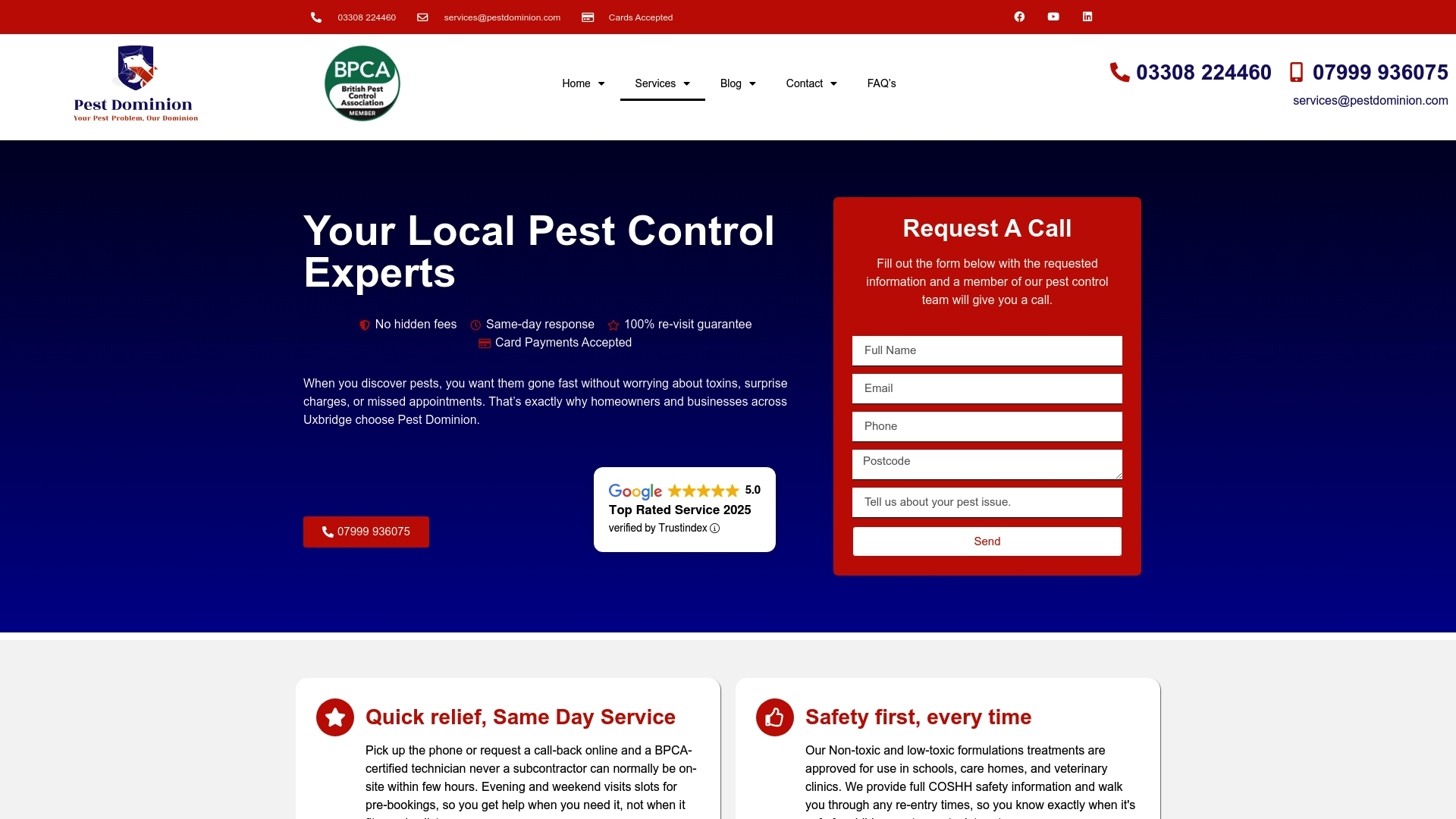Fumigation might sound like a last resort for out-of-control pest problems, but it plays a crucial role in keeping homes, businesses, and even food supplies safe. Think pest control just means a quick spray or setting traps. Not quite. Fumigation can reach every hidden crevice, with studies showing it eliminates pests from over 99 percent of treated areas. Rather than a simple fix, it is a meticulously planned operation that can save property owners from expensive repairs and serious health risks few people ever see coming.
Fumigation Essentials: What This Page Covers
- What Is Fumigation And Its Purpose?
- Why Is Fumigation Important For Property Owners?
- How Fumigation Works: Chemical Processes Explained
- Key Concepts In Fumigation: Types And Techniques
- Real-World Applications Of Fumigation In Various Sectors
Quick Summary
| Takeaway | Explanation |
|---|---|
| Fumigation eliminates pests comprehensively. | It targets hard-to-reach areas, ensuring thorough pest eradication across structures or defined spaces. |
| Prevention of health risks is crucial. | Fumigation removes disease-carrying organisms, significantly improving safety for occupants in treated spaces. |
| Regular fumigation supports property value. | Consistent treatments prevent damage and maintain the aesthetic appeal and market value of properties. |
| Financial losses can be mitigated through fumigation. | Early intervention saves on repairs caused by pest infestations, protecting the property owner’s investment. |
| Fumigation techniques vary by application. | Different strategies exist to address specific pest challenges in agricultural, industrial, and healthcare environments. |
What is Fumigation and Its Purpose?
Fumigation represents a sophisticated pest control methodology designed to eliminate pests comprehensively across entire structures or specific areas. This advanced treatment involves introducing gaseous chemicals or substances into an enclosed space to eradicate insects, rodents, fungi, and other unwanted organisms with exceptional precision and effectiveness.
Understanding the Core Purpose of Fumigation
The primary objective of fumigation extends far beyond simple pest removal. Research from the Centers for Disease Control highlights its critical role in preventing potential health risks and property damage associated with persistent pest infestations. Fumigation serves multiple essential functions:
- Completely eliminates pest populations from challenging-to-reach areas
- Prevents potential structural damage caused by insects and rodents
- Provides long-lasting protection against future pest reoccurrence
- Protects human health by removing disease-carrying organisms
How Fumigation Works
Fumigation operates through a meticulously controlled process where specialized chemicals are released as dense gas or vapour within a completely sealed environment. These chemicals penetrate every microscopic crack, crevice, and hidden space, ensuring thorough pest eradication. The treatment typically involves three critical stages: preparation, treatment, and aeration.
Professional pest control specialists carefully calculate precise chemical concentrations, exposure times, and environmental conditions to guarantee maximum effectiveness while maintaining safety protocols. Different types of fumigants are selected based on the specific pest challenge, structure type, and desired outcomes.
Whether addressing commercial warehouses, residential properties, or agricultural storage facilities, fumigation provides a robust solution for comprehensive pest management, protecting both property integrity and human health with unparalleled precision.
Why is Fumigation Important for Property Owners?
Property ownership comes with substantial responsibilities for maintaining structural integrity and protecting valuable investments. Fumigation emerges as a critical strategy for safeguarding properties against potentially catastrophic pest-related damages and health risks.
Financial Protection and Asset Preservation
Research from the Health and Safety Executive demonstrates that unchecked pest infestations can lead to significant financial losses. For property owners, fumigation represents a proactive defence mechanism against potential structural deterioration and economic challenges. Key financial benefits include:
- Preventing extensive structural damage caused by wood-destroying insects
- Protecting valuable inventory and stored materials from contamination
- Reducing long-term maintenance and repair expenses
- Maintaining property market value and aesthetic appeal
Health and Safety Considerations
Beyond financial implications, fumigation plays a crucial role in creating safe living and working environments. Pest infestations can introduce serious health hazards, including respiratory problems, allergic reactions, and potential transmission of dangerous diseases. Professional fumigation eliminates these risks by comprehensively targeting pest populations and their potential breeding grounds.
Long-Term Property Management Strategy
Successful property management requires strategic, forward-thinking approaches. Fumigation is not merely a reactive solution but a preventative measure that supports ongoing property maintenance. Professional treatments create protective barriers, reducing the likelihood of future infestations and helping property owners maintain consistent, high-quality environments.

By investing in regular, professional fumigation services, property owners demonstrate commitment to protecting their assets, ensuring occupant safety, and maintaining optimal property conditions across residential, commercial, and industrial settings.
How Fumigation Works: Chemical Processes Explained
Fumigation represents a sophisticated scientific approach to pest management, utilizing complex chemical interactions to eliminate unwanted organisms systematically and thoroughly. The process involves precise deployment of volatile chemical agents designed to penetrate and neutralise pest populations across entire environments.
Chemical Agent Mechanisms
Research from the Health and Safety Executive reveals that fumigants operate through intricate biological disruption mechanisms. These chemical agents target fundamental physiological processes of pests, rendering them incapable of survival. The primary modes of action include:
- Interrupting cellular respiration mechanisms
- Destroying protein synthesis pathways
- Blocking critical metabolic functions
- Generating lethal toxic environments for pests
Penetration and Distribution Dynamics
Fumigants possess unique molecular characteristics that enable exceptional infiltration capabilities. These gaseous substances can permeate microscopic cracks, penetrate porous materials, and distribute uniformly throughout sealed environments. This comprehensive coverage ensures that no potential hiding spaces remain unexposed, guaranteeing thorough pest elimination.
Safety and Controlled Application
Professional fumigation requires meticulous planning and execution. Specialists carefully calculate chemical concentrations, exposure durations, and environmental conditions to maximise effectiveness while maintaining strict safety protocols. Different fumigant types are selected based on specific pest challenges, structure characteristics, and desired treatment outcomes.
The chemical processes underlying fumigation represent a remarkable intersection of chemistry, biology, and pest management technologies, providing property owners with a powerful tool for comprehensive pest control and environmental protection.
Key Concepts in Fumigation: Types and Techniques
Fumigation encompasses a diverse range of sophisticated techniques designed to address specific pest control challenges across various environments. Understanding the nuanced approaches and specialist methodologies is crucial for effective pest management and property protection.
Fumigation Method Classifications
Research from the Environmental Protection Agency highlights multiple distinct fumigation strategies tailored to different scenarios. These methodological approaches are categorised based on treatment objectives, target pest populations, and environmental considerations
To help clarify the different categories of fumigation, the following table summarises the main types, their purposes, and typical applications.
| Fumigation Type | Primary Purpose | Typical Application |
|---|---|---|
| Structural Fumigation | Treat entire buildings to eradicate infestations | Residential and commercial properties |
| Commodity Fumigation | Protect stored goods from pest contamination | Warehouses, agricultural storage |
| Soil Fumigation | Eliminate pests in soil before planting | Agricultural fields and greenhouses |
| Container Fumigation | Control pests in confined cargo spaces | Shipping containers and freight transport |
![]() :
:
- Structural Fumigation: Comprehensive treatment for entire buildings
- Commodity Fumigation: Protecting stored agricultural products
- Soil Fumigation: Eliminating underground pest populations
- Container Fumigation: Treating shipping containers and enclosed spaces
Chemical Agent Selection
Successful fumigation depends on precise chemical agent selection matching specific pest control requirements. Different fumigants possess unique characteristics determining their effectiveness against particular organisms. Professionals evaluate multiple factors including:
- Pest species vulnerability
- Environmental temperature and humidity
- Structural material compatibility
- Potential residual effects
- Ecological impact considerations
Technical Application Protocols
Professional fumigation requires stringent technical protocols ensuring maximum efficacy and safety. The process involves comprehensive planning, specialised equipment, and meticulous execution. Trained technicians implement sophisticated techniques including complete area sealing, precise chemical concentration calculations, and controlled exposure duration management.
These intricate fumigation techniques represent a sophisticated intersection of scientific understanding, technical expertise, and targeted pest management strategies, enabling property owners to address complex biological challenges with exceptional precision.
Real-World Applications of Fumigation in Various Sectors
Fumigation extends far beyond traditional pest control, representing a critical intervention strategy across multiple industries and environmental contexts. Its versatility and effectiveness make it an essential tool for maintaining safety, protecting assets, and preventing potential biological risks.
Agricultural and Food Processing Sectors
Research from the Food and Agriculture Organization demonstrates fumigation’s pivotal role in preserving agricultural commodities and preventing significant economic losses. Food production and storage environments require robust pest management strategies to maintain product quality and safety. Key applications include:
- Protecting stored grain and cereal stocks
- Preventing insect contamination in warehouses
- Eliminating potential disease vectors in food processing facilities
- Maintaining international trade compliance for exported agricultural products
Industrial and Shipping Infrastructure
Industrial environments present complex pest management challenges that demand sophisticated fumigation techniques. Shipping containers, warehouses, and large-scale manufacturing facilities rely on comprehensive pest control to ensure operational integrity. Fumigation serves critical functions such as:
- Preventing invasive species transmission through international shipping
- Protecting sensitive electronic and mechanical equipment
- Maintaining hygiene standards in manufacturing environments
- Eliminating potential biological contamination risks
Healthcare and Public Health Applications
Beyond commercial settings, fumigation plays a crucial role in maintaining public health standards. Medical facilities, research institutions, and quarantine spaces utilise advanced fumigation techniques to create sterile environments and prevent potential disease transmission. Specialized fumigation protocols help control potential biological risks across sensitive institutional contexts.
These diverse applications underscore fumigation’s significance as a sophisticated, scientifically-driven approach to environmental management and biological risk mitigation across multiple professional sectors.
Ready to Eliminate Hidden Pests and Guard Your Property?
Are you concerned about pests hiding in hard-to-reach places or worried about unseen damage to your property? This article explained how fumigation tackles deep infestations and protects your investment from structural harm and health risks. At Pest Dominion Limited, we understand the stress pests can bring and the importance of long-term prevention. Our fumigation solutions penetrate every crack, just as described above, ensuring complete pest removal and safeguarding your environment.

Your property deserves expert protection now. Visit Pest Dominion Limited to see how our accredited, local team provides safe and effective pest control for homes and businesses in Slough and beyond. Contact us today for a thorough inspection and transparent advice. Secure your peace of mind by choosing proven professionals who understand what true property care means.
Frequently Asked Questions
What is fumigation and how does it work?
Fumigation is a pest control method that involves introducing gaseous chemicals into a sealed environment to eliminate a range of pests, including insects and rodents. The chemicals penetrate every crack and crevice, ensuring complete eradication of pests through precise biological disruption mechanisms.
Why is fumigation important for property owners?
Fumigation is crucial for property owners as it prevents significant structural damage caused by pests, protects valuable assets from contamination, and reduces long-term maintenance costs. Furthermore, it creates safer living and working environments by eliminating health hazards associated with pest infestations.
What are the different types of fumigation techniques?
Fumigation techniques can be classified into various methods based on the treatment target, including structural fumigation for entire buildings, commodity fumigation for stored agricultural products, soil fumigation for underground pests, and container fumigation for shipping containers and enclosed spaces.
How often should fumigation be performed for optimal pest control?
The frequency of fumigation depends on various factors, including the type of property, the prevalence of pests, and environmental conditions. Regular inspections and professional recommendations can help determine an appropriate fumigation schedule to maintain pest control and protect property integrity.

